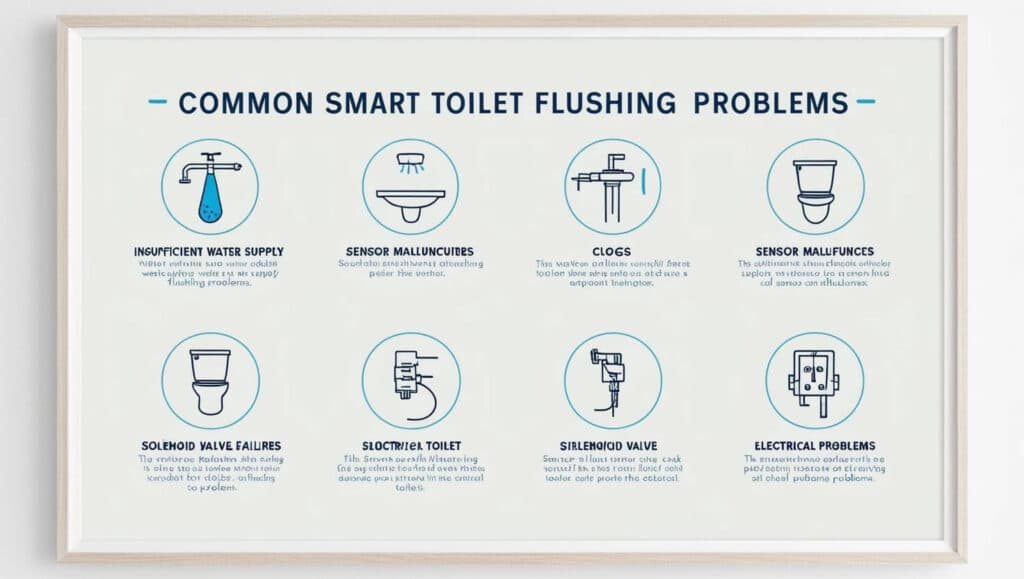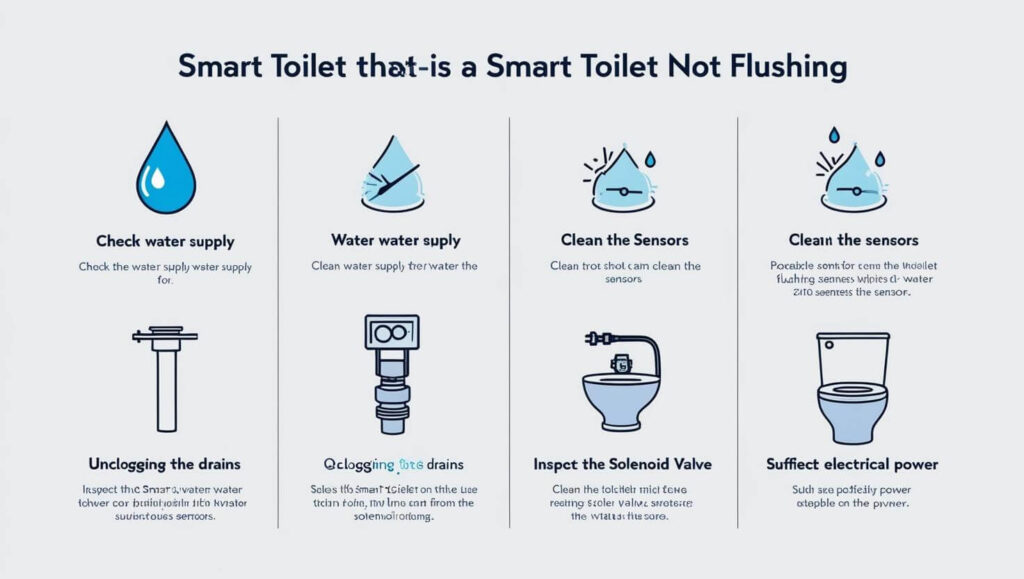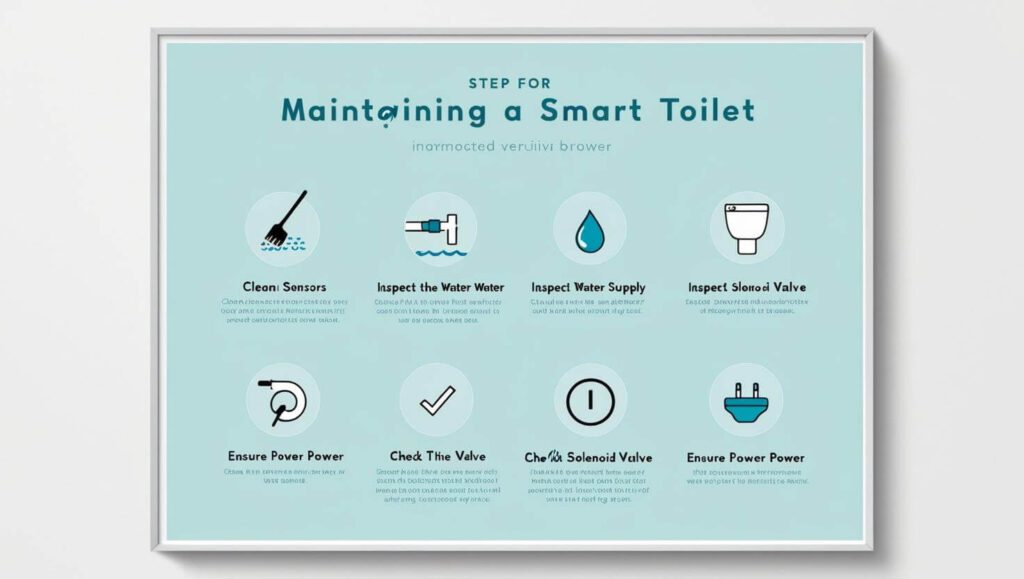Introduction
A smart toilet offers a high-tech, luxurious bathroom experience, but like any piece of technology, it can encounter issues. One of the most frustrating problems is when your smart toilet isn’t flushing properly. Whether it’s due to a sensor malfunction, water supply issue, or a clog, it’s essential to identify and fix the problem quickly.
In this article, we’ll guide you through the common causes of a smart toilet not flushing and provide a step-by-step troubleshooting guide to help you resolve the issue.
Here’s what you’ll learn:
✔ The common causes of a smart toilet not flushing.
✔ A detailed troubleshooting guide to help you fix flushing problems.
✔ Tips on preventing future flushing issues.
✔ Frequently asked questions about smart toilet malfunctions.
By the end of this guide, you’ll be equipped to solve most flushing problems yourself, ensuring your smart toilet works smoothly and efficiently again.
Common Causes of Smart Toilet Not Flushing
When your smart toilet stops flushing, it can be caused by a variety of issues, ranging from water supply problems to sensor malfunctions. Identifying the root cause is the first step to getting your toilet back in working order. Here are the most common reasons your smart toilet might not be flushing:

💧 Water Supply Issues
- Water Valve
✔ If the water valve to the toilet is partially or fully closed, the toilet won’t have enough water to flush properly.
✔ Check that the water valve is fully open to ensure that the toilet is receiving an adequate supply of water. - Low Water Pressure
✔ If the water pressure is too low, the toilet’s flushing mechanism might not work.
✔ You can check water pressure by running the faucet or shower in the bathroom to see if the pressure is normal. If it’s low, you may need to consult a plumber.
🛠️ Sensor Malfunction
- Motion Sensor
✔ Most smart toilets rely on motion sensors or presence sensors to trigger the flush automatically when you leave the seat. If the sensor is blocked, dirty, or damaged, it might not trigger the flush properly.
✔ Cleaning the sensor with a soft cloth or resetting it could solve the issue. - Failure to Detect User Presence
✔ If the sensor fails to detect your presence when seated, the toilet might not flush automatically. In this case, check the sensor’s positioning and cleanliness.
🔧 Clogged or Blocked Drain
- Physical Blockage
✔ A clogged drain or blocked waste pipe can prevent the toilet from flushing. A blockage can also interfere with the water flow, causing the toilet to fail to flush.
✔ Use a plunger or plumbing snake to clear any blockages in the toilet’s drain.
⚙️ Faulty Solenoid Valve
- Solenoid Valve Failure
✔ The solenoid valve controls water flow into the toilet tank. If it’s malfunctioning, it can prevent the toilet from flushing by blocking water from entering the tank.
✔ Check for a faulty valve and replace it if necessary.
⚡ Electrical Issues
- Power Supply Problems
✔ Some smart toilets use electrical components to control flushing. If there’s a power failure or faulty wiring, the toilet might not flush automatically.
✔ Check the power supply to the toilet and reset the system if needed.
Step-by-Step Troubleshooting Guide
If your smart toilet is not flushing, don’t worry! You can resolve most flushing problems by following a few simple troubleshooting steps. This guide will walk you through the diagnosis and fixes for the most common issues affecting your toilet’s ability to flush.

1️⃣ Check the Water Supply
- Verify the Water Valve
✔ Make sure the water valve is fully open. A partially closed valve will prevent enough water from entering the toilet’s tank, causing flushing issues.
✔ If the valve is open but the issue persists, check for any water pressure problems in the house. - Test the Water Pressure
✔ Run a faucet or shower in the bathroom to ensure normal water pressure. If the pressure is low, this may be the cause of the flushing issue.
✔ If the pressure is low, you may need a professional plumber to inspect the water supply.
2️⃣ Inspect and Clean the Sensor
- Clean the Sensor
✔ The motion or presence sensor detects when the user sits and when they leave, triggering the flush.
✔ Clean the sensor with a soft cloth to remove any dust or debris that may be blocking its function.
✔ If the sensor is still not working, try resetting it or consult the manufacturer for troubleshooting tips. - Check Sensor Positioning
✔ Ensure that the sensor is positioned correctly and not obstructed. If the sensor is misaligned, it might fail to detect movement.
3️⃣ Clear Any Blockages
- Check for Clogs
✔ If your toilet is clogged, it may not flush properly. Use a plunger or a plumbing snake to clear any blockages in the drain.
✔ If the clog is stubborn, you may need to call a plumber for assistance. - Check the Toilet Bowl and Drain
✔ Inspect the toilet bowl and drain for any visible obstructions. If there is no blockage, proceed to the next step.
4️⃣ Inspect the Solenoid Valve
- Examine the Solenoid Valve
✔ The solenoid valve controls water flow to the tank. If it’s faulty, it may prevent water from entering the tank or cause issues with flushing.
✔ Turn off the water supply, remove the solenoid valve, and check it for any visible issues such as blockages or wear.
✔ If necessary, replace the valve to restore proper flushing function.
5️⃣ Check the Electrical Supply
- Verify the Power Supply
✔ Some smart toilets rely on electrical components to operate. Ensure the toilet is properly connected to power and there are no electrical failures.
✔ If the toilet isn’t receiving power, check the outlet, wiring, and fuse.
✔ Reset the toilet or replace any faulty electrical components to restore functionality.
Tips for Preventing Future Flushing Issues
Once you’ve successfully fixed your smart toilet flushing issue, it’s important to take steps to maintain and prevent future problems. Regular maintenance and careful usage can help ensure that your toilet continues to function smoothly and avoid costly repairs in the future.

🧼 Regular Cleaning
- Clean the Sensors
✔ The sensors in your smart toilet can accumulate dust, grime, and soap residue over time. Regularly clean the sensors to ensure they continue to function properly.
✔ Use a soft, damp cloth and avoid abrasive cleaners that could damage the sensor. - Wipe Down Toilet Components
✔ Keep the bidet nozzles, flush buttons, and control panels clean to ensure all features are working as expected.
✔ Avoid using harsh chemicals that could interfere with the toilet’s electronic components.
🚿 Check the Water Supply Regularly
- Inspect Water Valve
✔ Periodically check that the water valve is fully open to prevent water flow restrictions.
✔ If you notice fluctuations in water pressure, address it sooner to avoid potential flushing problems. - Monitor Water Pressure
✔ Check the water pressure periodically by turning on faucets or showers in your bathroom. If it drops below normal levels, consider consulting a plumber.
🔧 Inspect the Solenoid Valve
- Inspect Regularly
✔ Check the solenoid valve for any visible issues like wear, rust, or clogging. Regular inspections can help you spot problems early before they affect the flushing mechanism.
✔ If the solenoid valve is malfunctioning, it may need to be replaced to prevent future issues.
⚡ Power Supply Checks
- Ensure Proper Power
✔ Check that the smart toilet is properly connected to a reliable power source.
✔ Periodically test the electrical connections to ensure the toilet’s electronic components are functioning correctly. - Reset the System
✔ If your smart toilet uses electrical components for flushing, periodically reset the system to avoid minor malfunctions from interrupting the flushing process.
Frequently Asked Questions (FAQs)
If your smart toilet isn’t flushing properly, you might have several questions about the cause of the issue and how to resolve it. Below are some of the most common questions users have when dealing with a smart toilet not flushing.
❓ How do I manually flush a smart toilet?
✅ Manual flush options are available on most smart toilets, allowing you to flush even if the automatic system isn’t working.
✔ Look for the flush button on the toilet or use the remote control to manually trigger the flush.
✔ If the button or remote is not working, you can typically press the flush lever or handle manually as a backup.
❓ Why won’t my smart toilet flush automatically?
✅ There are a few reasons this could happen:
✔ Sensor malfunction: The motion or presence sensor might not be detecting you properly.
✔ Water supply issue: If there’s not enough water pressure, the toilet won’t be able to flush.
✔ Solenoid valve failure: A faulty solenoid valve can prevent the toilet from receiving water to flush.
✔ Electrical failure: The toilet may have an electrical malfunction affecting its flushing system.
❓ How can I fix my smart toilet if it’s not flushing?
✅ Follow the step-by-step troubleshooting guide in this article to check for water supply issues, sensor malfunctions, clogs, and more.
✔ If you are unable to resolve the issue, it may be necessary to replace a faulty component like the solenoid valve or contact customer support for assistance.
❓ Can I fix the flushing problem myself?
✅ Many flushing issues can be resolved by following the troubleshooting guide, such as cleaning the sensor, checking the water valve, or unclogging the toilet.
✔ However, if the problem is related to the solenoid valve or electrical components, you may need to consult a professional to avoid causing further damage.
❓ How do I prevent my smart toilet from having flushing problems in the future?
✅ To prevent future issues:
✔ Regularly clean the sensors, toilet components, and nozzles.
✔ Inspect the water supply and plumbing regularly to avoid low water pressure.
✔ Check the solenoid valve for damage or blockages, and ensure the toilet is properly connected to power.
Final Thoughts
In conclusion, a smart toilet not flushing can be frustrating, but with the right troubleshooting steps, most issues can be resolved quickly and easily. Whether it’s a water supply issue, a sensor malfunction, or a clog, following the step-by-step guide will help you identify and fix the problem.
Should You Choose a Smart Toilet?
✅ Smart Toilet:
- Smart toilets are perfect for those who value comfort, luxury, and advanced hygiene features.
- While costlier than regular toilets, they provide long-term benefits such as water savings, improved hygiene, and eco-friendliness.
✅ Regular Toilet:
- Ideal for those on a budget or looking for a basic solution.
- Requires manual operation and lacks the advanced features of a smart toilet but is still a reliable option.
Final Tip:
Smart toilets are more than just a luxury; they offer a sustainable and hygienic bathroom experience. If you’ve encountered issues with your smart toilet not flushing, try the troubleshooting steps and perform regular maintenance to keep everything working smoothly.

